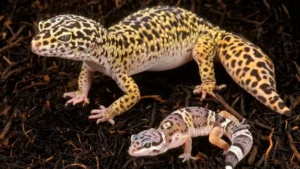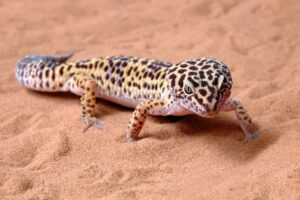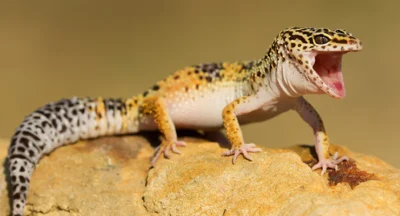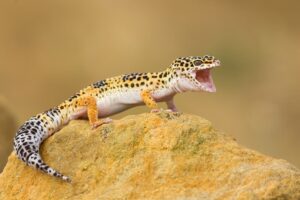Leopard geckos, beloved for their unique appearance and relatively low maintenance, thrive in environments carefully tailored to meet their specific needs. Central to their well-being is maintaining an optimal temperature within their habitat. In this guide, we’ll delve into the critical question: “What temperature does a leopard gecko need?”
Leopard geckos require a warm environment to thrive. During the day, the ambient air temperature in their enclosure should be around 85°F to 90°F (29°C to 32°C) on the warm side and around 75°F to 80°F (24°C to 27°C) on the cooler side. At night, the temperature can drop by a few degrees, but it should not go below 70°F (21°C).
It’s essential to provide a temperature gradient within the enclosure so that the gecko can regulate its body temperature by moving between warmer and cooler areas as needed. Heating pads, ceramic heat emitters, or overhead heat lamps can be used to maintain the appropriate temperature levels.
Understanding Leopard Gecko Temperature Needs

Understanding the temperature needs of a leopard gecko is crucial for providing them with a comfortable and healthy environment. Leopard geckos are ectothermic, meaning they rely on external heat sources to regulate their body temperature. Here’s a breakdown of their temperature requirements:
- Warm Side Temperature: The warm side of the enclosure should be maintained at around 85°F to 90°F (29°C to 32°C) during the day. This temperature range allows leopard geckos to properly digest food, stay active, and regulate their metabolism.
- Cool Side Temperature: The cooler side of the enclosure should be around 75°F to 80°F (24°C to 27°C) during the day. This area provides a retreat for the gecko if it becomes too warm and allows for thermal regulation.
- Nighttime Temperature: While leopard geckos can tolerate slightly cooler temperatures at night, it’s essential to ensure that the temperature doesn’t drop below 70°F (21°C). Nighttime temperatures can be allowed to drop a few degrees, simulating the natural temperature fluctuations they would experience in the wild.
- Temperature Gradient: Providing a temperature gradient within the enclosure is crucial. This means having a warm side and a cool side, allowing the gecko to move between areas to regulate its body temperature as needed.
- Heating Sources: Various heating sources can be used to achieve and maintain the appropriate temperatures in the enclosure. Under-tank heating pads, ceramic heat emitters, or overhead heat lamps are common options. It’s essential to use thermostats with heating elements to prevent overheating and ensure temperature stability.
- Monitoring Temperatures: Regularly monitor temperatures within the enclosure using reliable thermometers placed on both the warm and cool sides. This helps ensure that the temperature remains within the appropriate range and allows for adjustments if needed.
By understanding and meeting these temperature requirements, you can create a comfortable and suitable environment for your leopard gecko, promoting their overall health and well-being.
What temperature does a leopard gecko need?
Leopard geckos are ectothermic, meaning they rely on external heat sources to regulate their body temperature. To ensure their well-being, it’s crucial to provide them with an appropriate thermal gradient within their enclosure. The temperature range required for leopard geckos is as follows:
- Basking Area: This is the warmer end of the enclosure where the leopard gecko can thermoregulate by basking. The temperature in this area should be around 88-92°F (31-33°C). This allows the gecko to raise its body temperature as needed for digestion, metabolism, and overall activity.
- Cooler Area: On the opposite end of the enclosure, there should be a cooler area where the gecko can retreat if it becomes too warm. The temperature in this region should be around 75-80°F (24-27°C). This provides a comfortable area for the gecko to rest without overheating.
To achieve these temperature gradients, you can use various heating equipment such as:
- Under Tank Heaters (UTH): Placed beneath one side of the enclosure to create a warm spot for basking.
- Ceramic Heat Emitters (CHE): These emit heat without light and can be used to maintain ambient temperatures.
- Heat Lamps: Infrared heat lamps can be used to create a basking spot, but be cautious as they emit light which can disrupt the gecko’s day-night cycle if used at night.
- Thermostats: Essential for regulating the temperature of heating devices to prevent overheating.
It’s crucial to monitor the temperatures regularly using thermometers placed at both ends of the enclosure to ensure they remain within the appropriate range. Providing this thermal gradient allows the leopard gecko to regulate its body temperature effectively, promoting overall health and well-being.
Recommended Temperature Ranges
Bearded dragons are reptiles native to Australia known for their friendly demeanor and relatively easy care in captivity. Maintaining the right temperature range is crucial for their health and well-being because, like all reptiles, they are ectothermic, meaning they rely on external heat sources to regulate their body temperature.
Here are the recommended temperature ranges for bearded dragons:
- Basking Area: Bearded dragons need a basking spot where they can warm themselves up. The basking area temperature should range between 95°F to 105°F (35°C to 40°C). This area should be provided by a basking lamp or ceramic heat emitter placed at one end of the enclosure.
- Cool Side: The opposite end of the enclosure should be cooler, providing a retreat for the dragon to cool down when needed. This area should be around 75°F to 85°F (24°C to 29°C). You can achieve this by allowing the ambient room temperature to influence this side or using a low-wattage heat source.
- Nighttime Drop: It’s important for the temperature to drop slightly at night to mimic the natural temperature fluctuations in their habitat. Nighttime temperatures can drop to around 65°F to 75°F (18°C to 24°C). It’s best not to let the temperature drop below 65°F (18°C) as prolonged exposure to lower temperatures can be harmful.
- Thermoregulation: Bearded dragons are excellent at regulating their body temperature. Providing a gradient of temperatures allows them to move between warmer and cooler areas as needed to maintain their preferred body temperature.
- Thermometers: It’s crucial to regularly monitor the temperatures in the enclosure using thermometers placed at both the basking and cool ends. This ensures that the temperatures remain within the appropriate ranges and allows you to make adjustments if necessary.
Failure to provide the correct temperature gradients can lead to health issues such as poor digestion, lethargy, and susceptibility to illness. By maintaining the recommended temperature ranges, you can help ensure that your bearded dragon stays healthy and happy.
Monitoring and Adjusting Temperatures



